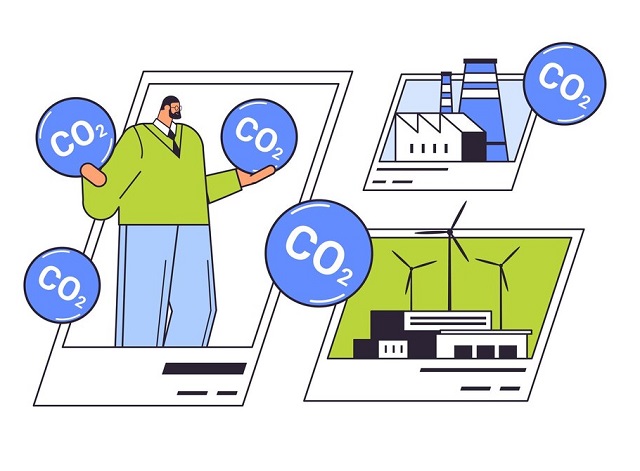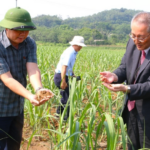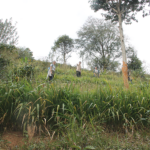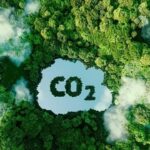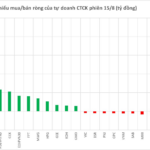Negative Carbon Assets: The Emerging Asset Class in a Zero-Carbon Economy
Negative carbon assets represent a novel asset class as the world transitions towards carbon neutrality. Unlike traditional carbon assets that solely focus on emission reduction, negative carbon assets offer the unique ability to actively absorb and store CO₂ from the atmosphere in a sustainable manner.
According to the IPCC AR6, negative carbon assets encompass natural forests and afforestation, regenerative agricultural practices, carbon capture and storage technologies (CCS/CCUS), as well as natural ecosystems such as mangroves and wetlands capable of CO₂ absorption. [1] [2] Unlike carbon neutrality and carbon credits, negative carbon assets create value by permanently removing carbon from the atmosphere.
An increasing number of investors, ESG funds, and financial institutions are recognizing the importance of negative carbon assets. The World Bank estimates that achieving global net-zero emissions by 2050 will require an annual investment of $260 billion in emission reduction solutions in the agricultural sector, with a significant portion directed towards negative carbon assets. [3] IETA’s 2023 report underscores the evolving focus of the voluntary carbon market towards quality and sustainability, with negative carbon assets playing a pivotal role. [4]
Quantitative metrics for evaluating negative carbon assets include CO₂ absorption capacity per hectare per year (tCO₂-eq/ha/year), carbon credit market value, and payback period. UNEP projects that nature-based solutions can mitigate up to 11.7 gigatons of CO₂ annually by 2030, accounting for over 40% of global emission reduction needs. [5] Microsoft’s commitment to investing $1 billion in the Climate Innovation Fund for carbon removal technologies underscores the strategic significance of negative carbon assets. [6]
Despite their evident environmental value, negative carbon assets are not yet formally recognized on the balance sheets of most businesses, resulting in a significant valuation gap, especially since traditional metrics like P/B or EBITDA fail to capture carbon absorption potential.
Integrating carbon accounting into financial reporting and ESG evaluation will be a pivotal step in green capital mobilization and sustainable listing strategies. In the near future, companies holding negative carbon assets may command higher valuations due to their ability to generate carbon credit revenues and access international ESG funding.
The Diverse Approaches of Businesses in Accumulating Negative Carbon Assets: From Forests to Technology
Global businesses are actively building portfolios of negative carbon assets through diverse approaches, ranging from direct forest land ownership to investments in advanced carbon capture technologies.
In the realm of afforestation, companies are investing in internationally certified projects to issue carbon credits. The World Bank announced plans to support 15 countries in generating over 24 million carbon credits from forest protection by 2024, with the potential to reach 126 million credits by 2028, translating to a value of $2.5 billion. [7] Vietnam successfully transferred 10.3 million carbon credits from its natural forests to the World Bank at a rate of $5 per ton of CO₂. [8]
Carbon capture and storage technologies (CCUS/BECCS) are attracting significant investment attention. Shell has committed to the final investment decision for the Polaris project in Canada, capable of capturing 650,000 tons of CO₂ annually, along with the Atlas Carbon Storage Hub for permanent underground CO₂ storage. [9] Shell’s operating and investment costs for CCS opportunities increased by 55% from $220 million in 2022 to $340 million in 2023. [10]
Microsoft signed the largest carbon removal agreement to date, committing to purchase 6.75 million tons of CO₂ over 15 years from the AtmosClear BECCS facility, valued at an estimated $800 million. [11] This signifies Microsoft’s shift towards carbon removal projects with “longer-lasting and higher impact” rather than merely purchasing unattached renewable energy credits.
Additionally, the “carbon banking” model in agriculture is gaining traction, enabling farmers to sell carbon credits by adopting sustainable farming practices. Green Carbon Inc., a Japanese company, signed an agreement with 22 provinces in Vietnam to implement a project reducing methane emissions from rice paddies using the Alternate Wetting and Drying (AWD) method, aiming to generate approximately 4 million tons of carbon credits over seven years. [12] [13]
Shopify has taken a leading role in the e-commerce sector by investing $5 million annually in its Sustainability Fund, focused on purchasing carbon removal credits. [14] In 2021, the company bought enough carbon credits to offset nearly 60,000 tons of emissions from Black Friday Cyber Monday shipping activities. [15] Shopify also purchased 3,250 tons of carbon removal credits from MASH Makes through biochar technology, demonstrating its commitment to sustainable carbon removal solutions. [16]
 Illustration.
|
Barriers and Challenges: The Complexities of Valuing Negative Carbon Assets
Despite their immense potential, negative carbon assets face challenges related to transparency, quality, and accurate valuation within the current financial system.
There is currently no globally recognized accounting framework for incorporating negative carbon assets on corporate balance sheets. The World Bank’s “Shadow Price of Carbon in Economic Analysis” guidance, released in 2024, recommends a carbon price range of $40-80/ton CO₂ in 2020, increasing to $50-100/ton in 2030. [17] However, achieving uniform adoption of these standards remains difficult.
Transparency issues and fraud in the carbon credit market are eroding investor confidence. An investigation in 2023 revealed that over 90% of Verra-certified forest carbon credits were “worthless.” [18] KPMG warns of market integrity risks that can arise at any stage of the value chain, from the creation of carbon credits to final transactions. [19]
Concerns related to long-term sustainability (“permanence”) and “leakage” present additional challenges. IOSCO has identified environmental integrity concerns, including the complexity of accurately measuring and verifying emission reductions and the potential reversibility of natural projects. [20] Forest projects may be susceptible to wildfires, diseases, or illegal logging, while CCS projects must ensure the secure storage of CO₂ for centuries.
The lack of a comprehensive management system and fragmentation in certification standards further complicate the landscape. With over 20 different carbon standards in the market, ranging from Verra VCS to Gold Standard and national standards, inconsistencies arise in quality and valuation methodologies. Carbon Market Watch highlights the challenge of independently assessing projects due to a lack of transparency in project documentation and carbon registry information. [21]
A comparison of policies across ASEAN countries reveals significant disparities in carbon taxation and investment incentives. While the EU has an effective ETS system, Vietnam is just beginning to establish its legal framework for a carbon market with Decision 232/QD-TTg, expected to pilot in June 2025. [22] Vietnam is considering allowing companies to use up to 30% of carbon credits to offset emissions during the initial phase. [23]
Vietnam’s Opportunity to Lead in Accumulating Negative Carbon Assets
With over 14.87 million hectares of forests (including 10.1 million hectares of natural forests and 4.7 million hectares of plantations), Vietnam possesses significant potential for supplying forest carbon credits. Regions such as the Northeast, North Central Coast, South Central Coast, and Central Highlands can absorb more than 21 million tons of CO₂ annually from natural forests. According to the Forestry Bureau, Vietnam could generate approximately 40-70 million forest carbon credits during 2021-2030, valued at an estimated $200 million to $5 billion if the credit price remains at $5 per ton of CO₂. [24]
In the agricultural sector, projects focused on reducing methane emissions in rice production are underway. Green Carbon Inc. has signed an agreement with 22 provinces to implement the AWD project on up to 266,000 hectares of rice paddies, with a particular focus on the Mekong Delta region. [25] Hung Yen province has agreed to allocate up to 27,000 hectares of rice paddies for the project over the next decade. [26]
Regarding industrial CCS, Vietnam can develop projects to capture carbon from heavy industries such as cement, steel, and chemicals. While no large-scale CCS projects have been implemented yet, the Power Development Plan VIII aims for 28-36% of renewable energy by 2030, providing a foundation for the development of negative carbon technologies. [27]
Decision 232/QD-TTg on the establishment and development of the carbon market outlines a roadmap: finalizing the legal framework by June 2025, piloting from 2025-2028, and officially operating from 2029. Vietnam is also one of the few Asian countries with a legal framework recognizing the role of forest carbon in climate change adaptation and mitigation.
To seize this opportunity, Vietnam needs to integrate negative carbon assets into its national financial system through various mechanisms. The Hanoi Stock Exchange will manage the carbon exchange, facilitating participation from both domestic and international investors. [28] Developing green credit, carbon securitization, and dedicated funds for negative carbon assets will effectively mobilize capital for these projects.
The Ministry of Finance is collaborating with the Ministry of Agriculture and the Ministry of Environment to formulate a decree on the domestic carbon exchange and regulations for international emissions trading within the Paris Agreement framework.
Vietnam has the potential to become the carbon trading hub of Southeast Asia by successfully establishing a trusted carbon exchange and carbon registry system. This will attract international investors, generate sustainable revenue for the economy, and contribute to the country’s commitment to achieving net-zero emissions by 2050, as pledged at COP26.
[1] https://www.ipcc-nggip.iges.or.jp/public/mtdocs/pdfiles/2407_Background_CDR_CCUS.pdf
[2] https://www.ipcc.ch/report/ar6/wg3/downloads/outreach/IPCC_AR6_WGIII_Factsheet_CDR.pdf
[3] https://www.worldbank.org/en/news/press-release/2024/05/07/recipe-for-livable-planet
[4] https://www.ieta.org/ieta-publishes-new-paper-on-the-evolution-of-the-voluntary-carbon-market/
[5] https://www.unep.org/unep-and-nature-based-solutions
[6] https://blogs.microsoft.com/blog/2020/01/16/microsoft-will-be-carbon-negative-by-2030/
[7] https://www.worldbank.org/en/news/press-release/2023/12/01/world-bank-carbon-credits-to-boost-international-carbon-markets
[8] https://vietnamagriculture.nongnghiep.vn/promising-new-potential-of-forest-carbon-credit-in-vietnam-d408011.html
[9] https://carbonherald.com/shell-announces-new-carbon-capture-and-storage-projects-in-canada/
[10] https://www.shell.com/investors/results-and-reporting/annual-report-archive/_jcr_content/root/main/section_812377294/tabs/tab/text.multi.stream/1742905301176/ce28b952e201476287788cfcf35406e464f9785c/shell-annual-report-2023.pdf
[11] https://www.esgtoday.com/microsoft-signs-largest-ever-permanent-carbon-removal-purchase-agreement/
[12] https://green-carbon.co.jp/en/enverralistsfirstricepaddyproject/
[13] https://green-carbon.co.jp/en/en-a-major-event-in-vietnam-co-hosted-with-government-agencies/
[14] https://www.shopify.com/news/fighting-for-the-future-shopify-invests-5m-in-breakthrough-sustainability-technologies
[15] https://www.shopify.com/blog/bfcm-carbon-removal-2021
[16] https://www.mashmakes.com/blog/news-shopify-purchases-3-250-tonnes-of-carbon-removal-credits-from-mash-makes
[17] https://documents1.worldbank.org/curated/en/099553203142424068/pdf/IDU1c94753bb1819e14c781831215580060675b1.pdf
[18] http://eprints.lse.ac.uk/122618/1/Carbon_credit_transparency_NatSustain_Final.pdf
[19] https://kpmg.com/xx/en/our-insights/esg/integrity-issues-in-the-voluntary-carbon-markets.html
[20] https://www.iosco.org/library/pubdocs/pdf/IOSCOPD774-note.pdf
[21] https://carbonmarketwatch.org/wp-content/uploads/2024/04/CMW-Lost-in-Documentation-Transparency-in-voluntary-carbon-market-registries.pdf
[22] https://www.kwm.com/global/en/insights/latest-thinking/vietnam-sets-the-stage-for-carbon-trading.html
[23] https://www.reccessary.com/en/news/vn-regulation/vietnam-eyes-30-carbon-offset-cap-to-ease-corporate-burden
[24] https://vietnamagriculture.nongnghiep.vn/net-zero–a-distant-goal-coming-closer-challenge-of-tripling-carbon-absorption-from-forests-d409448.html
[25] https://green-carbon.co.jp/en/100haproject/
[26] https://green-carbon.co.jp/en/hungyen_en/
[27] https://theinvestor.vn/renewables-to-account-for-28-36-of-vietnams-energy-output-by-2030-adjusted-pdp-viii-d15327.html
[28] https://www.kwm.com/global/en/insights/latest-thinking/vietnam-sets-the-stage-for-carbon-trading.html
The New 117 Million Ton Resource Trove: A Massive Windfall Awaits if Exports Take Off
The agricultural sector emits nearly 117 million tons of CO2 equivalent. This presents an opportunity to tap into a new resource reservoir by adopting farming practices that reduce emissions. By embracing sustainable methods, not only can we mitigate our environmental footprint, but we can also explore the potential of carbon credit exports, given the high demand for this commodity.
Carbon Credit Sales: Empowering Farmers to Prosper
Ecological agriculture and circular farming are not just methods of cultivation, but a philosophy that strives for long-term sustainability for both people and the planet. With a shared goal of achieving Net Zero by 2050, Vietnam’s agricultural sector is undergoing a transformation towards ecological farming practices to protect natural resources and community health, paving the way for a green, clean, and resilient future.
“Carbon Credits: Refining Standards to Unlock Forest Development Opportunities”
Following COP21, the Prime Minister directed the Ministry of Agriculture and Rural Development, along with other relevant ministries, to initiate tasks in line with the new agreement. Notably, this includes a commitment to contribute 100% of carbon credits towards the nationally determined contributions (NDCs). For the period 2021–2025, Vietnam aims to generate 25 million carbon credits, a significant step towards a sustainable future.


























